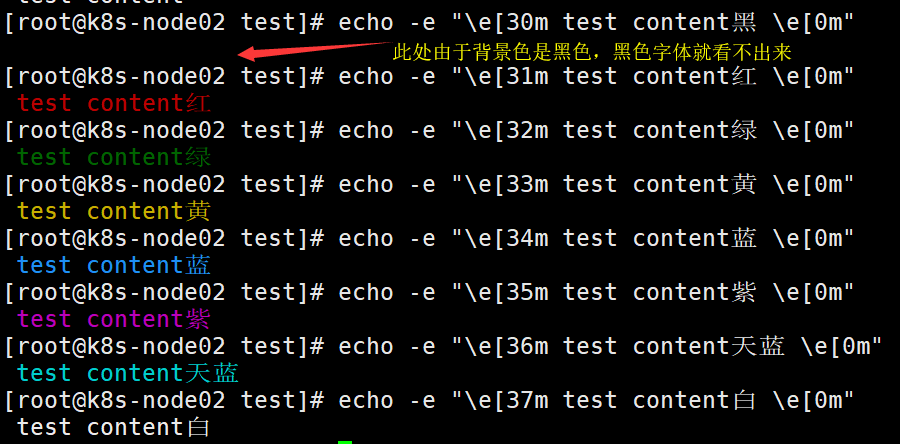Shell~echo -e 颜色输出
echo -e 可以控制字体颜色和背景颜色输出
从一个例子开始:
# echo -e "\e[1;33;41m test content \e[0m"
输出效果:

. \e 转义起始符,定义一个转义序列, 可以使用 \033代替
. [ 表示开始定义颜色
. 1表示高亮,33表示字体颜色为黄色,45表示背景色为红色
. “test content” 属于文字内容
. m 转义终止符,表示颜色定义完毕
. 再次使用 \e[ ,表示再次开启颜色定义,0表示使用默认的颜色,m表示颜色定义结束,所以 \e[0m 的作用是恢复之前的配色方案
一、字体颜色
字体颜色:30——37
默认=0,黑色=30,红色=31,绿色=32,黄色=33,蓝色=34,紫色=35,天蓝色=36,白色=3
[root@k8s-node02 test]# echo -e "\e[30m test content黑 \e[0m"
test content黑
[root@k8s-node02 test]# echo -e "\e[31m test content红 \e[0m"
test content红
[root@k8s-node02 test]# echo -e "\e[32m test content绿 \e[0m"
test content绿
[root@k8s-node02 test]# echo -e "\e[33m test content黄 \e[0m"
test content黄
[root@k8s-node02 test]# echo -e "\e[34m test content蓝 \e[0m"
test content蓝
[root@k8s-node02 test]# echo -e "\e[35m test content紫 \e[0m"
test content紫
[root@k8s-node02 test]# echo -e "\e[36m test content天蓝 \e[0m"
test content天蓝
[root@k8s-node02 test]# echo -e "\e[37m test content白 \e[0m"
test content白
输出效果:

二、字背景颜色
字背景颜色:40——47
默认=0,黑色=40,红色=41,绿色=42,黄色=43,蓝色=44,紫色=45,天蓝色=46,白色=47
[root@k8s-node02 test]# echo -e "\e[40m test content黑 \e[0m"
test content黑
[root@k8s-node02 test]# echo -e "\e[41m test content红 \e[0m"
test content红
[root@k8s-node02 test]# echo -e "\e[42m test content绿 \e[0m"
test content绿
[root@k8s-node02 test]# echo -e "\e[43m test content黄 \e[0m"
test content黄
[root@k8s-node02 test]# echo -e "\e[44m test content蓝 \e[0m"
test content蓝
[root@k8s-node02 test]# echo -e "\e[45m test content紫 \e[0m"
test content紫
[root@k8s-node02 test]# echo -e "\e[46m test content天蓝 \e[0m"
test content天蓝
[root@k8s-node02 test]# echo -e "\e[47m test content白 \e[0m"
test content白
输出效果:

三、黑底彩色
黑底彩色:90——97
黑=90 深红=91 绿=92 黄色=93 蓝色=94 紫色=95 深绿=96 白色=97
[root@k8s-node02 test]# echo -e "\e[90m test content黑 \e[0m"
test content黑
[root@k8s-node02 test]# echo -e "\e[91m test content红 \e[0m"
test content红
[root@k8s-node02 test]# echo -e "\e[92m test content绿 \e[0m"
test content绿
[root@k8s-node02 test]# echo -e "\e[93m test content黄 \e[0m"
test content黄
[root@k8s-node02 test]# echo -e "\e[94m test content蓝 \e[0m"
test content蓝
[root@k8s-node02 test]# echo -e "\e[95m test content紫 \e[0m"
test content紫
[root@k8s-node02 test]# echo -e "\e[96m test content天蓝 \e[0m"
test content天蓝
[root@k8s-node02 test]# echo -e "\e[97m test content白 \e[0m"
test content白
输出结果:

四、字体控制选项:
\033[0m 关闭所有属性
\033[1m 设置高亮度
\033[4m 下划线
\033[5m 闪烁
\033[7m 反显,撞色显示,显示为白色黑底,或者显示为黑底白字
\033[8m 消影,字符颜色将会与背景颜色相同
\033[nA 光标上移n行
\033[nB 光标下移n行
\033[nC 光标右移n行
\033[nD 光标左移n行
\033[y;xH 设置光标位置
\033[2J 清屏
\033[K 清除从光标到行尾的内容
\033[s 保存光标位置
\033[u 恢复光标位置
\033[?25l 隐藏光标
\033[?25h 显示光标
五、实例演示
1.示例1:定义颜色变量
# vim color_test1.sh
#!/bin/bash
# 定义颜色变量,\、\e、\E是等价的,都是转义起始符
RED='\e[1;31m' # 红
GREEN='\e[1;32m' # 绿
YELLOW='\033[1;33m' # 黄
BLUE='\E[1;34m' # 蓝
PINK='\E[1;35m' # 粉红
RES='\033[0m' # 清除颜色 echo -e "${RED} Red ${RES}"
echo -e "${YELLOW} Yellow ${RES}"
echo -e "${BLUE} Blue ${RES}"
echo -e "${GREEN} Green ${RES}"
echo -e "${PINK} Pink ${RES}"
# source color_test1.sh

2.示例2:定义颜色动作
# vim color_test2.sh
#!/bin/bash
# 定义颜色动作
SETCOLOR_SUCCESS="echo -en \\E[1;32m"
SETCOLOR_FAILURE="echo -en \\E[1;31m"
SETCOLOR_WARNING="echo -en \\E[1;33m"
SETCOLOR_NORMAL="echo -en \\E[0;39m" # 使用时直接调用颜色动作,跟上相应的内容
$SETCOLOR_SUCCESS && echo test1
$SETCOLOR_FAILURE && echo test2
$SETCOLOR_WARNING && echo test3
$SETCOLOR_NORMAL && echo test4
需要注意其中的一些细节:
(1)需要增加-n选项,这样引用时不会出现换行的问题。
(2)\\本质是\,在双引号中反斜线符号一定要写成\\。
(3)引用变量要放到其他语句前面,并使用&&连接。
# source color_test2.sh

六、tput命令
tput 命令会利用 terminfo 数据库中的信息,来控制和更改我们的终端,比如控制光标、更改文本属性、控制屏幕,以及为文本涂色。
其中,为文本涂色的方法是:
tput setab:用于设置背景色
tput setaf:用于设置前景色
sgr0:表示颜色重置
颜色定义如下:

改写 实例演示中的 color_test1.sh
#!/bin/bash
# 定义颜色变量,\、\e、\E是等价的,都是转义起始符
RED=$(tput setaf ) # 红
GREEN=$(tput setaf ) # 绿
YELLOW=$(tput setaf ) # 黄
BLUE=$(tput setaf ) # 蓝
PINK=$(tput setaf ) # 粉红
RES=$(tput sgr0) # 清除颜色 echo -e "${RED} Red ${RES}"
echo -e "${YELLOW} Yellow ${RES}"
echo -e "${BLUE} Blue ${RES}"
echo -e "${GREEN} Green ${RES}"
echo -e "${PINK} Pink ${RES}"
# source color_test1.sh

Shell~echo -e 颜色输出的更多相关文章
- shell实现带颜色输出的进度条
1.基础版 #!/bin/bash b='' ;$i<=;i+=)) do printf "执行进度 :[%-50s]%d%%\r" $b $i sleep 0.001 b= ...
- 【Shell】带颜色输出(白底x色)
echo -e "\033[31mHello World.\033[0m" 红色31m 绿色32m 黄色33m 蓝色34m 黑色30m 白色37m 紫色35m 深绿色36m
- 让shell脚本中的echo输出带颜色
转载自:http://www.linuxidc.com/Linux/2014-12/110463.htm 让echo输出带颜色的方法有两种 1.在shell脚本中定义颜色变量,使用echo -e调用变 ...
- shell脚本颜色输出(实例未编辑)
颜色输出通过echo 输出,需要加-e echo -e "\033[背景颜色;字体颜色\033[0m" 背景颜色 40 设置黑色背景 41 设置红色背景 42 设置绿色背景 43 ...
- Linux终端和win32控制台文本颜色输出
在使用putty.secureCRT.XShell等终端仿真器连接linux系统时,ls.vim等工具的输出都含有各种颜色,这些颜色的输出大大地增强了文本的可读性. 通常我们可以使用echo命令加-e ...
- shell 终端字符颜色
终端的字符颜色是用转义序列控制的,是文本模式下的系统显示功能,和具体的语言无关,shell,python,perl等均可以调用. 转义序列是以 ESC 开头,可以用 \033 完成相同的工作(ESC ...
- (转)shell脚本输出带颜色字体
shell脚本输出带颜色字体 原文:http://blog.csdn.net/andylauren/article/details/60873400 输出特效格式控制:\033[0m 关闭所有属性 ...
- jenkins调用shell脚本 输出带颜色字体
jenkins需要安装AnsiColor插件在构建环境项选择“color ansi console output” 安装插件AnsiColor shell 脚本相关颜色设置 echo -e " ...
- shell单引号中输出参数值
因为在shell的单引号中,所有的特殊字符和变量都会变成文本,那么如果需要在字符串中输出变量值怎么办呢? 这里记录以下两种方法: 使用双引号 shell> X='parameter' shell ...
随机推荐
- 【机器学习笔记】ID3构建决策树
好多算法之类的,看理论描述,让人似懂非懂,代码走一走,现象就了然了. 引: from sklearn import tree names = ['size', 'scale', 'fruit', 'b ...
- CentOS6 + MapServer7.4编译
先升级gcc 1.python3.6 ./configure --enable-shared --enable-profiling make –j 20 make install 2.proj-4.9 ...
- vue3.0和2.0的区别,Vue-cli3.0于 8月11日正式发布,更快、更小、更易维护、更易于原生、让开发者更轻松
vue3.0和2.0的区别Vue-cli3.0于 8月11日正式发布,看了下评论,兼容性不是很好,命令有不少变化,不是特别的乐观vue3.0 的发布与 vue2.0 相比,优势主要体现在:更快.更小. ...
- 汇编之JCC指令
版权声明:本文为博主原创文章,转载请附上原文出处链接和本声明.2019-09-06,21:59:16.作者By-----溺心与沉浮----博客园 JCC指令决定它跳不跳转跟别的没关系,只跟EFLAG标 ...
- sparkstreaming 黑名单过滤
要用到transform and rdd.leftOuterJoin transform: 使 DStream 和 RDD 之间的类型进行了转换,然后可以进行调用 leftOuterJoin(左外连接 ...
- iptables 学习笔记
1. 安装iptables yum install iptables centos7: yum install -y iptables-services 2. service命令 查看iptables ...
- 8-剑指offer: 替换空格
题目描述 请实现一个函数,将一个字符串中的每个空格替换成"%20".例如,当字符串为We Are Happy.则经过替换之后的字符串为We%20Are%20Happy. 代码: c ...
- 第 33课 C++中的字符串(下)
字符串与数字转换-标准库中提供了相关的类对字符串和数字进行转换-字符串流类(sstream)用于string的转换.<sstream>-相关头文件.istringstream-字符串输入流 ...
- 剖析linux内核中的宏-----------offsetof
offsetof用于计算TYPE结构体中MEMBER成员的偏移位置. #ifndef offsetof#define offsetof(TYPE, MEMBER) ((size_t) &((T ...
- 如何使用jmockit进行单元测试
1. Jmockit简介 JMockit 是用以帮助开发人员编写测试程序的一组工具和API,它完全基于 Java 5 SE 的 java.lang.instrument 包开发,内部使用 ASM 库来 ...
